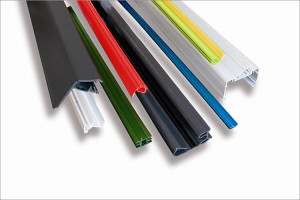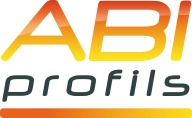
Plastic Profiles vs Co-extruded Profiles: The Differences
Plastic profiles and co-extruded profiles are both important and ubiquitous components in many industries. They can be found in the automotive industry, construction, and civil engineering, as well as in completely different sectors such as packaging and healthcare.
Plastic profiles and co-extruded profiles are both important and ubiquitous components in many industries. They can be found in the automotive industry, construction, and civil engineering, as well as in completely different sectors such as packaging and healthcare.
However, be aware: they differ in terms of manufacturing, properties, and applications. As experts in plastic profile manufacturing and plastic extrusion, we will detail these distinctions. The goal is to help you choose the product that best meets your specifications and desired functionalities. At the end of the article, a comparative table will summarize the major differences between a plastic profile and a co-extruded profile. Happy reading to all!
Do you have a specific project involving plastic profiles? Contact us directly via the form on the website right here.
What is a Plastic Profile?
Let’s start with the plastic profile to begin our comparison.
A plastic profile is a component manufactured by extruding plastic materials.
Extrusion in a few words: It is a continuous process of transforming plastic materials by pushing them continuously through a die, using an extruder. Plastic extrusion is the result obtained by this process, which is only possible thanks to an extruder.
For example, here are the types of plastic profiles that can be found:
- Single-wall or tubular plastic profile
- Multi-material & multi-color plastic profile
- Two-component plastic profile (co-extrusion)
- Single & bi-material plastic profile (co-extrusion)
- Single & bi-color plastic profile (co-extrusion)
- Opaque or transparent plastic profile
- Flexible or rigid plastic profile
- Thin and thick plastic profile
- Plastic profile with additional finishing options
- Semi-finished product (assembly & mounting)
- Label holder, poster clip, grippers, point-of-sale profile, etc.
At ABI Profils, we manufacture standard and specific plastic profiles using a wide range of materials. Indeed, different materials can be used for plastic profiles. Among the most common are thermoplastics such as polycarbonate and polyamide, as well as mass plastics like PE and PVC. The choice of material will depend on your specifications. Each plastic has its unique properties that make it suitable for particular applications.
Here are some of the materials available at ABI PROFILS: PVC, PP, PP FV, PE, PMMA, SEBS, PC, PA, PA FV, ABS, PS, PETG, ASA, TPV, TPU, and many others.
What is a Co-extruded Profile?
To compare with plastic profiles, let’s now talk about co-extruded plastic profiles (but also tri- and post-extruded profiles).
Co-extrusion is a more advanced process where two or more types of different polymer materials are extruded simultaneously using multiple extruders. This process allows combining different properties of materials into a single finished product.
At ABI Profils, we use co-extrusion to produce bi-material, tri-material, or multi-color profiles. This responds to a wide range of technical and aesthetic constraints.
Let us explain in more detail the differences between the various extrusion techniques we master, namely co-extrusion, tri-extrusion, and post-extrusion.
Co-extrusion
Firstly, co-extrusion allows combining two different polymers by extruding them simultaneously through a die. This process allows creating parts with combined properties, such as rigid and flexible materials or elements of two different colors.
Tri-extrusion
Tri-extrusion, on the other hand, uses three materials extruded together to obtain combinations of rigidity, flexibility, and chemical barriers. It meets even more specific applications. The materials are extruded through a die equipped with a main extruder and two co-extruders.
Post-extrusion
Finally, post-extrusion involves extruding a first rigid section and then adding a second, often more flexible material to finalize the profile. This process allows creating products with specific functional properties, such as sealing or clipping.
Main Differences Between Plastic Profiles and Co-extruded Profiles
To make the reading of the differences between plastic profiles and co-extruded profiles easier, we offer the following comparative table:
| Aspect | Plastic Profiles | Co-extruded Profiles |
|---|---|---|
| Manufacturing Process | Simple process involving a single extruder. The plastic material is melted and extruded through a die to form the desired profile. | Complex process requiring a main extruder and several co-extruders. Different materials are extruded simultaneously through a common die, combining distinct properties. |
| Material Properties | Have specific properties depending on the material used (PVC for rigidity and durability, PE for flexibility). | Allow combining the properties of several materials (e.g., rigid part for structure and flexible part for sealing). |
| Applications | Used in many fields (automotive, construction, dynamic storage, healthcare) for their strength, elasticity, weather and UV resistance. | Ideal for applications requiring multiple properties (automotive for door seals, construction for window profiles with improved thermal insulation, etc.). |
| Cost and Complexity | Less expensive to produce due to a simpler manufacturing process. | More complex process and use of multiple materials can sometimes lead to higher production costs. Advanced technical solutions justify the extra cost. |
| ABI Profils Advantages | Strength and durability: Resistance to wear, impact, and harsh weather conditions.<br> Flexibility and elasticity: Good plasticity.<br> Thermal and electrical insulation: Use for applications requiring effective insulation. | Double functionality: Combination of rigid and flexible materials for strong and flexible profiles.<br> Multilayer properties: Layers with different characteristics (UV resistance, flexibility).<br> Innovation and customization: Meeting specific design and functionality requirements. |
Conclusion
Choosing between a standard plastic profile and a co-extruded profile largely depends on your needs in terms of specifications, material properties, and applications. Plastic profiles are perfectly suited for simple solutions. On the other hand, co-extruded profiles offer more advanced technical solutions for applications requiring multiple material properties.
At ABI Profils, we provide solutions tailored to each project. We offer our expertise and know-how in plastic extrusion and co-extrusion to meet your needs. Our entire technical team and design office work to develop profiles that exactly meet your requirements.
For any information request or to discuss your project, do not hesitate to contact us. We are here to advise and support you in the realization of your plastic or co-extruded profiles.
ABI PROFILS: Expertise at the service of your innovation!
Back to news home page


 Français
Français Česky
Česky Deutsch
Deutsch Slovenský
Slovenský Belgisch-Nederlands
Belgisch-Nederlands